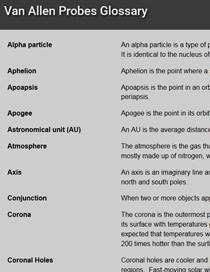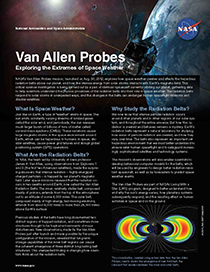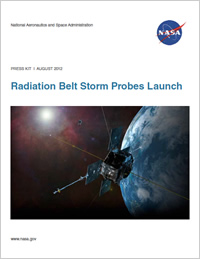News CenterResources

Glossary »
Archived Event Materials
December 4, 2012 - AGU 2012 Fall Meeting
"New Findings, New Enigmas: NASA's Van Allen Probes Begin their Exploration of the Radiation Belts"
Presenter: Nicola Fox, Deputy Project Scientist, Van Allen Probes, Johns Hopkins University Applied Physics Laboratory, Laurel, Maryland
[Fox 1]
Daniel Baker, Principal Investigator, Van Allen Probes Relativistic Electron Proton Telescope (REPT; part of the Energetic Particle, Composition, and Thermal Plasma Suite), Laboratory for
Atmospheric and Space Physics (LASP) at the University of Colorado, Boulder
[Baker 1, Van Allen Probes launch and animations]
Craig Kletzing, Principal Investigator, Van Allen Probes Electric and Magnetic Field Instrument Suite and Integrated Science (EMFISIS), University of Iowa, Iowa City
[Kletzing 1, Chorus sound file]
Joseph Mazur, Principal Investigator, Van Allen Probes Relativistic Proton Spectrometer (RPS), Aerospace Corporation, Chantilly, Virginia
[Mazur 1]
August 9, 2012 - RBSP L-14 News Conference
Media from this event is available in high resolution at http://svs.gsfc.nasa.gov/vis/a010000/a011000/a011027/.
Van Allen Probes Glossary
| Alpha particle | An alpha particle is a type of particle radiation that is made up of two protons and two neutrons bound together. It is identical to the nucleus of the element helium. |
| Aphelion | Aphelion is the point where a satellite (natural or human-made) is farthest from the sun in its orbit. |
| Apoapsis | Apoapsis is the point in an orbit when two objects are farthest apart. When they are closest together it is called periapsis. |
| Apogee | Apogee is the point in its orbit where a satellite (natural or human-made) is farthest from Earth. |
| Astronomical unit (AU) | An AU is the average distance from Earth to the sun, about 93 million miles, or 150 million kilometers. |
| Atmosphere | The atmosphere is the gas that surrounds a planet or star, and is held in place by gravity. Earth's atmosphere is mostly made up of nitrogen, while the sun's atmosphere consists mainly of hydrogen. |
| Axis | An axis is an imaginary line around which something rotates. The Earth’s axis for instance, passes through the north and south poles. |
| Conjunction | When two or more objects appear near one another in the sky, it is said that they are in conjunction. |
| Corona | The corona is the outermost part of a star’s atmosphere. The sun’s corona extends millions of kilometers from its surface with temperatures greater than a million degrees. This is fascinating to scientists because it would be expected that temperatures would drop as the distance from the sun’s core increases, yet the corona is about 200 times hotter than the surface. |
| Coronal Holes | Coronal holes are cooler and less dense areas in the sun’s corona, and they appear darker than surrounding regions. Fast-moving solar wind is known to come from coronal holes. |
| Coronal Mass Ejections | A coronal mass ejection, or CME, is a huge eruption on the surface of the sun that releases billions of tons of plasma with tremendous force. It is one of the biggest explosions in our solar system. The high-energy, high-speed particle radiation that is released during a CME can damage satellites, cause power outages on Earth, and create serious health concerns for astronauts. |
| Cosmic rays | Atomic nuclei (mostly protons) and electrons that crash into Earth's atmosphere with exceedingly high energies are called cosmic rays. |
| Cyclotron | A cyclotron is a circular machine that is used to accelerate charged particles to extremely high energies. It uses a magnetic field to bend the path of the particles so they move in a circle, repeatedly passing over plates whose charges switch back and forth from positive to negative—these alternating charges accelerate the particles. The high-energy particles collide with other particles, breaking them apart to reveal even smaller elementary particles within them. |
| Dipolar | The prefix “di-” means “two” or “double”, therefore dipolar means two or double poles. It refers to a magnetic field or electric field that has two equal and opposite points where the lines of force are most concentrated. Bar magnets, Earth, and the sun all have dipolar magnetic fields. |
| Density | Density refers to the amount of mass (“stuff”) in a certain space or volume. For example, an elevator with 12 people inside would have a greater density of people than the same elevator with only 2 passengers. |
| Electromagnetic radiation | Electromagnetic radiation or electromagnetic waves are produced by the motion of electrically charged particles. Radio waves, microwaves, visible light, and x-rays are all examples of electromagnetic radiation. |
| Electron | An electron is a negatively charged particle that orbits an atom’s nucleus. Electrons can be knocked out of their orbits through collisions with other particles or with electromagnetic radiation. Once free of their atoms, they can join other atoms or remain as free negative charges. |
| Electron volt (eV) | An electron volt is a unit of energy commonly used in particle physics. As an electron is pulled or pushed by Earth's magnetic field, its energy changes. We measure the amount of energy that an electron gains or loses in electron volts. An electron volt is a very tiny unit (1.6 × 10-19 Joules). For large energy changes, scientists may use kilo-electron volts (keV) which are equal to 1000 electron volts, or mega-electron volts (MeV) which are equal to 1,000,000 electron volts. |
| Flux | Flux is how quickly a certain amount of something such as energy, particles, or a volume of fluid moves through a certain area in a certain amount of time. Flux also refers to the strength of a magnetic or electric field in a given area. |
| Geospace | The prefix “geo-” is from Greek and means “Earth,” therefore, geospace is the region of space that surrounds Earth. Geospace extends from Earth’s upper atmosphere to the limits of its magnetic field. |
| Geomagnetic storm | A geomagnetic storm is a disturbance in Earth’s magnetosphere, caused by a solar event such as a flare or coronal mass ejection. |
| Ion | An ion is an atom or group of atoms that have a positive or negative electric charge. If the atom gains an electron it becomes a negatively charged ion. If the atom loses an electron it becomes a positively charged ion. |
| Magnetic field | The area around an object or an electric current where magnetism can be detected is called the magnetic field. Like bar magnets, both Earth and the sun have dipolar magnetic fields. The Earth’s magnetic field is very important because it helps to shield us from the harsh solar wind, solar flares, and coronal mass ejections. |
| Magnetic field lines | Magnetic field lines show the structure of a magnetic field. To see the field lines of a magnet, place a piece of paper over a magnet, then sprinkle iron filings on the paper. The iron will line up along the magnetic field lines. If you could do the same to the entire planet, you would see a similar pattern of field lines. |
| Magnetometer | A magnetometer is an instrument that detects the strength and direction of magnetic force. |
| Magnetopause | The magnetopause is the boundary between Earth’s magnetosphere and the solar wind. |
| Magnetosphere | The magnetosphere is the area of space around Earth that is influenced by the planet’s magnetic field. It traps charged particles from the sun and carves out a protective space in the solar wind. |
| Magnetotail | The magnetotail is the part of the magnetosphere that is pushed away from Earth by the solar wind. |
| Matter | Matter is any substance that has mass and takes up space. Physical objects are composed of matter in the form of atoms, which are made up of smaller particles called protons, neutrons, and electrons. |
| Nucleus | The nucleus is the core of an atom. It is made of positively charged protons, and neutrons which have no charge. The nucleus makes up most of the mass of an atom. |
| Particle radiation | Particle radiation is energy given off by fast-moving subatomic (smaller than an atom) particles like electrons or protons. While particle radiation from space usually doesn’t reach Earth’s surface, it can be dangerous for astronauts and can damage satellites. |
| Periapsis | Periapsis is the point in an orbit when two objects are closest together. It is the opposite of apoapsis. |
| Perigee | Perigee is the point in its orbit where a satellite (natural or human-made) is closest to Earth. |
| Perihelion | Perihelion is the point in its orbit where a satellite (natural or human-made) is closest to the sun. |
| Plasma | Plasma is a fourth state of matter distinct from solid, liquid, or gas and is present in places such as stars and lightening. Plasma is made of free electrons and ions, (atoms that have an electric charge because they have lost or gained electrons). When enough energy is added to atoms, they can begin to move quickly and collide with one another with enough force to knock electrons free. |
| Proton | Protons are positively charged particles that, along with neutrons, form the core or nucleus of an atom. The number of protons in an atomic nucleus is what distinguishes one element from another. |
| Radiation | Radiation refers to energy in the form of particles or waves. Some examples of radiation include visible light and x-rays. See the definitions of “electromagnetic radiation” and “particle radiation” for more detailed information. |
| Radiation belts | The radiation belts are two donut-shaped regions encircling Earth where high-energy electrons and ions are trapped by Earth’s magnetic field. They are often referred to as the “Van Allen Belts” because they were discovered by James Van Allen and his team at the University of Iowa, in 1958. |
| Relativistic | Relativistic refers to something moving at a velocity approaching the speed of light. |
| Ring current | The electric current made up of electrons and ions that encircle Earth is known as the ring current. It flows clockwise around the equator when viewed from the north. |
| Satellite | An object that orbits around a larger astronomical object is a satellite. It can refer to a natural object such as a moon orbiting a planet, or it can refer to a human-made object, such as a spacecraft put into orbit around the Earth to relay communications signals or transmit scientific data. |
| Solar flare | A solar flare is a violent eruption in the sun’s atmosphere that heats plasma and sends large amounts of solar particles hurtling into space at tremendous speeds. |
| Solar minimum and maximum | The period when the sun is most active with solar flares, sun spots, and coronal mass ejections, is known as the solar maximum. The solar minimum occurs when the sun is least active. The sun’s activity level is on an 11-year cycle. |
| Solar wind | The solar wind is a constant stream of plasma flowing from the surface of the sun. Other stars have stellar winds too. The winds are strongest near the end of the star’s life, when it has consumed most of its fuel. |
| South Atlantic Anomaly (or SAA) | The SAA is a region over the South Atlantic Ocean where the inner Van Allen radiation belt comes closest to Earth's surface. The SAA is produced by a dip in Earth's magnetic field at that location. The excess energy in this region presents a problem for satellites whose orbits take them through it, exposing them to several minutes of strong radiation each time. The International Space Station required extra shielding to deal with this problem and the Hubble Space Telescope does not take observations while passing through this region. |
| Spectrum (plural - spectra) | In general terms, a spectrum is a continuous sequence or range of something. A familiar example of a spectrum of visible light is a rainbow. |
| Spectrometer | A spectrometer is a tool that is used to measure and record the spectrum, or range, of light (or sometimes particles) coming from a particular source. |
| Spectroscopy | Spectroscopy is the use of light to study matter. Light is emitted, reflected, or absorbed differently by different types of matter. Almost like a fingerprint, each type of matter has a signature pattern in the way it gives off, reflects, or absorbs light. By using a spectrometer to study the spectra or range of wavelengths of light, a scientist can learn something about an objects motion, composition, temperature, and more, even if they can’t examine the object up close. For example, spectroscopy might be used to study what elements are present in a star millions of kilometers away. |
| Vacuum | A vacuum is space that is empty, or nearly empty, of all matter. |
| Van Allen | Dr. James Van Allen and his team at the University of Iowa discovered the Earth’s radiation belts in 1958. This scientific discovery was a first for the space-age. |
| Velocity | Velocity is the speed and direction of a moving object. |



